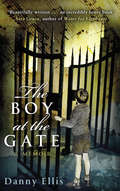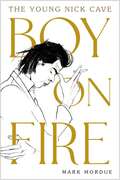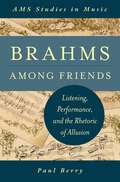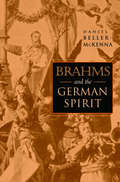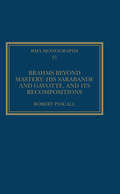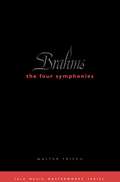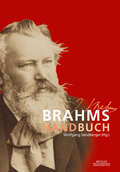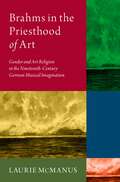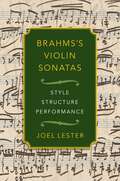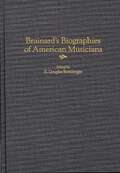- Table View
- List View
The Boy at the Gate: A Memoir
by Danny EllisDanny Ellis was a survivor, strong and resilient. A successful singer/songwriter, he was proud of the way he’d ‘handled’ his painful past: the grinding poverty of the 1950s Dublin slums, and the brutality of the orphanage, the notorious Artane Industrial School where he was left. He’d safely buried it. Or so he thought.Then one night, while writing a powerful song that would launch his acclaimed album, 800 Voices, his past came flooding back to haunt him. Long-forgotten memories of betrayal and abandonment burst forth in a shocking revelation: his eight-year-old self was still lost in the orphanage.Although badly shaken, Danny began a courageous journey that would lead him back to the streets of Dublin, to the tenement slums and, eventually, to the brutality and scallywag shenanigans of the Artane playground. What he found with each twist and turn of his odyssey would change his life for ever.The Boy at the Gate is a poignant, profoundly moving memoir of forgiveness and redemption, and an inspiring testament to the healing power of music and love.
Boy Bands and the Performance of Pop Masculinity
by Georgina GregoryBoy Bands and the Performance of Pop Masculinity provides a history of the boy band from the Beatles to One Direction, placing the modern male pop group within the wider context of twentieth- and twenty-first-century popular music and culture. Offering the first extended look at pop masculinity as exhibited by boy bands, this volume links the evolving expressions of gender and sexuality in the boy band to wider economic and social changes that have resulted in new ways of representing what it is to be a man. The popularity of boy bands is unquestionable, and their contributions to popular music are significant, yet they have attracted relatively little study. This book fills that gap with chapters exploring the challenges of defining the boy band phenomenon, its origins and history from the 1940s to the present, the role of management and marketing, the performance of gender and sexuality, and the nature of fandom and fan agency. Throughout, the author illuminates the ways in which identity politics influence the production and consumption of pop music and shows how the mainstream pop of boy bands can both reinforce and subvert gender and class hierarchies.
Boy Bands and the Performance of Pop Masculinity
by Georgina GregoryBoy Bands and the Performance of Pop Masculinity provides a history of the boy band from the Beatles to One Direction, placing the modern male pop group within the wider context of twentieth- and twenty-first-century popular music and culture. Offering the first extended look at pop masculinity as exhibited by boy bands, this volume links the evolving expressions of gender and sexuality in the boy band to wider economic and social changes that have resulted in new ways of representing what it is to be a man. The popularity of boy bands is unquestionable, and their contributions to popular music are significant, yet they have attracted relatively little study. This book fills that gap with chapters exploring the challenges of defining the boy band phenomenon, its origins and history from the 1940s to the present, the role of management and marketing, the performance of gender and sexuality, and the nature of fandom and fan agency. Throughout, the author illuminates the ways in which identity politics influence the production and consumption of pop music and shows how the mainstream pop of boy bands can both reinforce and subvert gender and class hierarchies.
The Boy in the Song: The Real Stories Behind 50 Classic Pop Songs
by Michael HeatleyThe Boy in the Song is a follow up to 2010's The Girl in the Song. It features the real-life stories that inspired some classic pop songs about the male of the species. While the first book was filled with songs about unrequited love, the follow-up is more varied, with songs written from a number of emotions. There are songs motivated by love and hate, there are tributes and there are biographical tales. Each song is featured on two, four or six pages with a small biography of the artist along with the story of how and why the song was written, and, most intriguingly, what happened after the song became a hit.
Boy on Fire: The Young Nick Cave
by Mark MordueAn intensely beautiful, profound and poetic biography of the formative years of the dark prince of rock 'n' roll, Boy on Fire is Nick Cave's creation story, a portrait of the artist first as a boy, then as a young man. A deeply insightful work which charts his family, friends, influences, milieu and, most of all, his music, it reveals how Nick Cave shaped himself into the extraordinary artist he would become.A powerful account of a singular, uncompromising artist, Boy on Fire is also a vivid and evocative rendering of a time and place, from the fast-running dark rivers and ghost gums of country-town Australia to the torn wallpaper, sticky carpet and manic energy of the nascent punk scene which hit staid 1970s Melbourne like an atom bomb. Boy on Fire is a stunning biographical achievement.
Boys in the Trees: A Memoir
by Carly Simon#1 New York Times BestsellerA People Magazine Top Ten Book of the Year'A sensational memoir . . . brilliantly well written. Carly Simon is incapable of writing a boring sentence . . . you can forgive anything for the unparalleled brilliance of her writing' - Lynn Barber, Sunday Times'Hugely affecting memoir . . . heartfelt and remarkable' - Fiona Sturges, IndependentCarly Simon is a household name. She was the staple of the '70s and '80s Billboard charts and was famously married to James Taylor with whom she has two children. She has had a career that has spanned four decades, resulting in thirteen top 40 hits, including the Number 1 song 'You're So Vain', numerous Grammy Awards, a Golden Globe and an Academy Award. She was the first artist in history to win a Grammy Award, an Academy Award and a Golden Globe Award for her song 'Let the River Run' (from the film Working Girl). Boys in the Trees is a rhapsodic, beautifully composed memoir of a young woman's coming of age amongst the glamorous literati and intelligentsia of Manhattan (her father was Richard Simon, co-founder of publishing giant Simon & Schuster), a reflection on a life begun amidst secrets and shame, and a powerful story of the strength to leave that all behind and forge a path of art, music and love in the Golden Age of folk and rock.At once an insider's look into a life in the spotlight, a lyric reflection on a particular time in our culture's history, and a beautiful memoir about the pains and joys of love and art, Boys in the Trees is the story Carly Simon has long been waiting to tell the world.Praise for the US edition:'One of the best celebrity memoirs of the year' Hollywood Reporter'Intelligent and captivating' People'Compelling' Rolling Stone
Brahms: The Great Composers (The Great Composers)
by Michael SteenWelcome to The Independent’s new ebook series The Great Composers, covering fourteen of the giants of Western classical music. Extracted from Michael Steen’s book The Lives and Times of the Great Composers, these concise guides, selected by The Independent’s editorial team, explore the lives of composers as diverse as Mozart and Puccini, reaching from Bach to Brahms, set against the social, historical and political forces which affected them, to give a rounded portrait of what it was like to be alive and working as a musician at that time. It was Schumann who first hailed Brahms as ‘the natural heir and successor to Beethoven’, and that is how many have seen him since, although to Brahms himself it was something of a burden. With his devotion to classical precepts, he proved himself a master of all the major forms bar one. His four symphonies, his concertos, his vast body of chamber music, where discipline underpins the wonderful romantic harmonies, remain central to the repertoire. During his own life, it was the rapturous reception of his German Requiem which established him beyond all doubt. The only form he never attempted was opera, which would have been ill-suited to his virtues as a composer. Michael Steen shows how Brahms came to be raised up as the champion of traditional values against the new music of composers such as Liszt and Wagner, in one of the most bitterly fought controversies of the age. On tour as a young man from Hamburg, Brahms met the violin virtuoso Joachim, who introduced him to Schumann. During Schumann's period of insanity and especially after his death, Brahms developed a lifelong friendship with his widow, Clara. Steen chronicles his autumns teaching in Detmold, his passing loves, and eventual move to Vienna, where he would spend his winters, escaping to a variety of resorts to compose over the summer. He died at 63, still a bachelor.
Brahms Among Friends: Listening, Performance, and the Rhetoric of Allusion (AMS Studies in Music)
by Paul BerryBrahms Among Friends identifies patterns of listening, performance, and composition among close friends of Johannes Brahms and explores how those patterns informed the creation and reception of his music in the intimate genres of song, sonata, trio, and piano miniature. Among the tangled threads of counterpoint and circumstance that bound Brahms to his acquaintances was the technique of allusive musical borrowing, whereby a brief passage from a familiar work was drawn into the fabric of a new composition. For the specific listeners whose habits of mind and musicianship he knew best, allusive borrowings could become rhetorically charged gestures, persuasively revising the meanings his music conveyed and the interpretive strategies it invited. Primary documents, original manuscripts, music-analytic comparison, and kinesthetic parameters experienced in the act of performance all work in tandem to support ten case studies in the interplay between Brahms's small-scale works and the women and men who encountered them before publication. Central characters include violinist Joseph Joachim, singers Amalie Joachim, Julius Stockhausen, and Agathe von Siebold, composers Heinrich and Elisabeth von Herzogenberg, and pianists Emma Engelmann and Clara Schumann. For these musicians and for the composer himself, Brahms's allusive music served a broad variety of emotional needs and interpersonal ends. Yet across diverse repertoire and interdisciplinary correlates ranging from ethnography to psychoanalysis, each case study furthers a single, underlying aim: to reconstruct the mutually dependent perspectives of historically situated agents and restore forgotten features of their communicative landscapes as bases for both musical and historical scrutiny.
Brahms and His World: (Revised Edition)
by Walter Frisch Kevin C. KarnesSince its first publication in 1990, Brahms and His World has become a key text for listeners, performers, and scholars interested in the life, work, and times of one of the nineteenth century's most celebrated composers. In this substantially revised and enlarged edition, the editors remain close to the vision behind the original book while updating its contents to reflect new perspectives on Brahms that have developed over the past two decades. To this end, the original essays by leading experts are retained and revised, and supplemented by contributions from a new generation of Brahms scholars. Together, they consider such topics as Brahms's relationship with Clara and Robert Schumann, his musical interactions with the "New German School" of Wagner and Liszt, his influence upon Arnold Schoenberg and other young composers, his approach to performing his own music, and his productive interactions with visual artists. The essays are complemented by a new selection of criticism and analyses of Brahms's works published by the composer's contemporaries, documenting the ways in which Brahms's music was understood by nineteenth- and early twentieth-century audiences in Europe and North America. A new selection of memoirs by Brahms's friends, students, and early admirers provides intimate glimpses into the composer's working methods and personality. And a catalog of the music, literature, and visual arts dedicated to Brahms documents the breadth of influence exerted by the composer upon his contemporaries.
Brahms and His World: (Revised Edition) (PDF)
by Walter Frisch Kevin C. KarnesSince its first publication in 1990, Brahms and His World has become a key text for listeners, performers, and scholars interested in the life, work, and times of one of the nineteenth century's most celebrated composers. In this substantially revised and enlarged edition, the editors remain close to the vision behind the original book while updating its contents to reflect new perspectives on Brahms that have developed over the past two decades. To this end, the original essays by leading experts are retained and revised, and supplemented by contributions from a new generation of Brahms scholars. Together, they consider such topics as Brahms's relationship with Clara and Robert Schumann, his musical interactions with the "New German School" of Wagner and Liszt, his influence upon Arnold Schoenberg and other young composers, his approach to performing his own music, and his productive interactions with visual artists. The essays are complemented by a new selection of criticism and analyses of Brahms's works published by the composer's contemporaries, documenting the ways in which Brahms's music was understood by nineteenth- and early twentieth-century audiences in Europe and North America. A new selection of memoirs by Brahms's friends, students, and early admirers provides intimate glimpses into the composer's working methods and personality. And a catalog of the music, literature, and visual arts dedicated to Brahms documents the breadth of influence exerted by the composer upon his contemporaries.
Brahms and the German Spirit
by Daniel. Beller-McKennaThe music of Johannes Brahms is deeply colored, Daniel Beller-McKenna shows, by nineteenth-century German nationalism and by Lutheran religion. Focusing on the composer's choral works, the author offers new insight on the cultural grounding for Brahms's music. Music historians have been reluctant to address Brahms's Germanness, wary perhaps of fascist implications. Beller-McKenna counters this tendency; by giving an account of the intertwining of nationalism, politics, and religion that underlies major works, he restores Brahms to his place in nineteenth-century German culture. The author explores Brahms's interest in the folk element in old church music; the intense national pride expressed in works such as the Triumphlied; the ways Luther's Bible and Lutheranism are reflected in Brahms's music; and the composer's ideas about nation building. The final chapter looks at Brahms's nationalistic image as employed by the National Socialists, 1933-1945, and as witnessed earlier in the century (including the complication of rumors that Brahms was Jewish). In comparison to the overtly nationalist element in Wagner's music, the German elements in Brahms's style have been easy to overlook. This nuanced study uncovers those nationalistic elements, enriching our understanding both of Brahms's art and of German culture.
Brahms and the German Spirit (PDF)
by Daniel Beller-McKennaThe music of Johannes Brahms is deeply colored, Daniel Beller-McKenna shows, by nineteenth-century German nationalism and by Lutheran religion. Focusing on the composer's choral works, the author offers new insight on the cultural grounding for Brahms's music. Music historians have been reluctant to address Brahms's Germanness, wary perhaps of fascist implications. Beller-McKenna counters this tendency; by giving an account of the intertwining of nationalism, politics, and religion that underlies major works, he restores Brahms to his place in nineteenth-century German culture. The author explores Brahms's interest in the folk element in old church music; the intense national pride expressed in works such as the Triumphlied; the ways Luther's Bible and Lutheranism are reflected in Brahms's music; and the composer's ideas about nation building. The final chapter looks at Brahms's nationalistic image as employed by the National Socialists, 1933-1945, and as witnessed earlier in the century (including the complication of rumors that Brahms was Jewish). In comparison to the overtly nationalist element in Wagner's music, the German elements in Brahms's style have been easy to overlook. This nuanced study uncovers those nationalistic elements, enriching our understanding both of Brahms's art and of German culture.
Brahms and the Scherzo: Studies in Musical Narrative
by Ryan McClellandDespite the incredible diversity in Brahms's scherzo-type movements, there has been no comprehensive consideration of this aspect of his oeuvre. Professor Ryan McClelland provides an in-depth study of these movements that also contributes significantly to an understanding of Brahms's compositional language and his creative dialogue with musical traditions. McClelland especially highlights the role of rhythmic-metric design in Brahms's music and its relationship to expressive meaning. In Brahms's scherzo-type movements, McClelland traces transformations of primary thematic material, demonstrating how the relationship of the initial music to its subsequent versions creates a musical narrative that provides structural coherence and generates expressive meaning. McClelland's interpretations of the expressive implications of Brahms's fascinatingly intricate musical structures frequently engage issues directly relevant to performance. This illuminating book will appeal to music theorists, musicologists working on nineteenth-century instrumental music and performers.
Brahms and the Scherzo: Studies in Musical Narrative
by Ryan McClellandDespite the incredible diversity in Brahms's scherzo-type movements, there has been no comprehensive consideration of this aspect of his oeuvre. Professor Ryan McClelland provides an in-depth study of these movements that also contributes significantly to an understanding of Brahms's compositional language and his creative dialogue with musical traditions. McClelland especially highlights the role of rhythmic-metric design in Brahms's music and its relationship to expressive meaning. In Brahms's scherzo-type movements, McClelland traces transformations of primary thematic material, demonstrating how the relationship of the initial music to its subsequent versions creates a musical narrative that provides structural coherence and generates expressive meaning. McClelland's interpretations of the expressive implications of Brahms's fascinatingly intricate musical structures frequently engage issues directly relevant to performance. This illuminating book will appeal to music theorists, musicologists working on nineteenth-century instrumental music and performers.
Brahms Beyond Mastery: His Sarabande and Gavotte, and its Recompositions
by Robert PascallIn 1853 Robert Schumann identified fully-formed compositional mastery in the young Brahms, who nevertheless in the years following embarked on a period of intensive further study, producing, among other works, the neo-baroque Sarabande and Gavotte. These dances have not been properly recognized as constituting a distinct Brahms work before now, but manuscript evidence and their performance history indicate that Brahms and his friends thought of them as such in the mid-1850s, when they became the first music of his performed publicly in Gdansk, Vienna, Budapest and London. He later suppressed the dances, using them instead as a thematic quarry for three chamber music masterpieces, from different stages in his life and in distinctly different ways: the Second String Sextet, the First String Quintet and the Clarinet Quintet. This book gives an account of the compositional and performance history, stylistic features and re-uses of the dances, setting these in the wider context of Brahms‘s developing creative concerns and trajectory. It constitutes therefore a study of alost work, of how a fully-formed master opens himself tothe in-flowing from afar (in Martin Heidegger‘s terms), and of the transformative reach and concomitant expressive richness of Brahms‘s creative thought.
Brahms Beyond Mastery: His Sarabande and Gavotte, and its Recompositions
by Robert PascallIn 1853 Robert Schumann identified fully-formed compositional mastery in the young Brahms, who nevertheless in the years following embarked on a period of intensive further study, producing, among other works, the neo-baroque Sarabande and Gavotte. These dances have not been properly recognized as constituting a distinct Brahms work before now, but manuscript evidence and their performance history indicate that Brahms and his friends thought of them as such in the mid-1850s, when they became the first music of his performed publicly in Gdansk, Vienna, Budapest and London. He later suppressed the dances, using them instead as a thematic quarry for three chamber music masterpieces, from different stages in his life and in distinctly different ways: the Second String Sextet, the First String Quintet and the Clarinet Quintet. This book gives an account of the compositional and performance history, stylistic features and re-uses of the dances, setting these in the wider context of Brahms‘s developing creative concerns and trajectory. It constitutes therefore a study of alost work, of how a fully-formed master opens himself tothe in-flowing from afar (in Martin Heidegger‘s terms), and of the transformative reach and concomitant expressive richness of Brahms‘s creative thought.
Brahms: The Four Symphonies (PDF)
by Beth Baron"Walter Frisch provides a sensitive analytical commentary on the symphonies as well as a consideration of their place within Brahms's oeuvre, within the symphonic repertory of his day, and within the broader musical culture of nineteenth-century Germany and Austria. Frisch also pays particular attention to the evolution of performance style, describing how orchestra size, playing techniques, tempi, and articulation have changed since Brahms's symphonies were first heard."--BOOK JACKET
Brahms-Handbuch
Einer der wichtigsten Komponisten des 19. Jahrhunderts. Johannes Brahms gilt vielen als Endpunkt einer ästhetisch-historischen Entwicklung, als Galionsfigur, welche die Weltgeltung der deutschen Musik zum letzten Mal (Wilhelm Furtwängler) gesichert habe. Abgesehen von der Oper hat er in allen musikalischen Gattungen exemplarische Werke geschaffen. Führende Brahms-Forscher erkunden in diesem Handbuch seine Kompositionsweise sowie die Voraussetzungen und Wirkungen seines Werkes. Ein Muss für alle, die sich für Brahms Musik begeistern.
Brahms in the Priesthood of Art: Gender and Art Religion in the Nineteenth-Century German Musical Imagination
by Laurie McManusBrahms in the Priesthood of Art: Gender and Art Religion in the Nineteenth-Century German Musical Imagination explores the intersection of gender, art religion (Kunstreligion) and other aesthetic currents in Brahms reception of the nineteenth and early twentieth centuries. In particular, it focuses on the theme of the self-sacrificing musician devoted to his art, or "priest of music," with its quasi-mystical and German Romantic implications of purity seemingly at odds with the lived reality of Brahms's bourgeois existence. While such German Romantic notions of art religion informed the thinking on musical purity and performance, after the failed socio-political revolutions of 1848/49, and in the face of scientific developments, the very concept of musical priesthood was questioned as outmoded. Furthermore, its essential gender ambiguity, accommodating such performing mothers as Clara Schumann and Amalie Joachim, could suit the bachelor Brahms but leave the composer open to speculation. Supportive critics combined elements of masculine and feminine values with a muddled rhetoric of prophets, messiahs, martyrs, and other art-religious stereotypes to account for the special status of Brahms and his circle. Detractors tended to locate these stereotypes in a more modern, fin-de-siècle psychological framework that questioned the composer's physical and mental well-being. In analyzing these receptions side by side, this book revises the accepted image of Brahms, recovering lost ambiguities in his reception. It resituates him not only in a romanticized priesthood of art, but also within the cultural and gendered discourses overlooked by the absolute music paradigm.
Brahms in the Priesthood of Art: Gender and Art Religion in the Nineteenth-Century German Musical Imagination
by Laurie McManusBrahms in the Priesthood of Art: Gender and Art Religion in the Nineteenth-Century German Musical Imagination explores the intersection of gender, art religion (Kunstreligion) and other aesthetic currents in Brahms reception of the nineteenth and early twentieth centuries. In particular, it focuses on the theme of the self-sacrificing musician devoted to his art, or "priest of music," with its quasi-mystical and German Romantic implications of purity seemingly at odds with the lived reality of Brahms's bourgeois existence. While such German Romantic notions of art religion informed the thinking on musical purity and performance, after the failed socio-political revolutions of 1848/49, and in the face of scientific developments, the very concept of musical priesthood was questioned as outmoded. Furthermore, its essential gender ambiguity, accommodating such performing mothers as Clara Schumann and Amalie Joachim, could suit the bachelor Brahms but leave the composer open to speculation. Supportive critics combined elements of masculine and feminine values with a muddled rhetoric of prophets, messiahs, martyrs, and other art-religious stereotypes to account for the special status of Brahms and his circle. Detractors tended to locate these stereotypes in a more modern, fin-de-siècle psychological framework that questioned the composer's physical and mental well-being. In analyzing these receptions side by side, this book revises the accepted image of Brahms, recovering lost ambiguities in his reception. It resituates him not only in a romanticized priesthood of art, but also within the cultural and gendered discourses overlooked by the absolute music paradigm.
Brahms's Violin Sonatas: Style, Structure, Performance
by Joel LesterNotation in Johannes Brahms's sonata scores tells violinists and pianists far more than merely what pitches to play and how long to play them--if read carefully, these scores reveal an immense amount of expression, both of musical and human essences. Joel Lester's Brahms's Violin Sonatas magnifies key passages from these scores, revealing in clear and accessible language how the composer built his themes and musical narratives and how, ultimately, Brahms's music came to sound Brahmsian. Through close readings and annotated musical examples, Brahms's Violin Sonatas guides practitioners to read scores with care and to develop their own informed interpretation of the pieces, eschewing the notion of a single "correct" interpretation of the historical score. By exploring not only the sonatas' musical elements, but also their relationship to important events in the composer's life, Lester shows how subtle components can communicate the gestures, moods, personalities, and emotions that make Brahms's music so compelling. A companion volume to the author's award-winning 1999 study Bach's Works for Solo Violin: Style, Structure, and Performance (OUP), Brahms's Violin Sonatas is a clear and practical guide to understanding and performing Brahms's music in the present.
Brahms's Violin Sonatas: Style, Structure, Performance
by Joel LesterNotation in Johannes Brahms's sonata scores tells violinists and pianists far more than merely what pitches to play and how long to play them--if read carefully, these scores reveal an immense amount of expression, both of musical and human essences. Joel Lester's Brahms's Violin Sonatas magnifies key passages from these scores, revealing in clear and accessible language how the composer built his themes and musical narratives and how, ultimately, Brahms's music came to sound Brahmsian. Through close readings and annotated musical examples, Brahms's Violin Sonatas guides practitioners to read scores with care and to develop their own informed interpretation of the pieces, eschewing the notion of a single "correct" interpretation of the historical score. By exploring not only the sonatas' musical elements, but also their relationship to important events in the composer's life, Lester shows how subtle components can communicate the gestures, moods, personalities, and emotions that make Brahms's music so compelling. A companion volume to the author's award-winning 1999 study Bach's Works for Solo Violin: Style, Structure, and Performance (OUP), Brahms's Violin Sonatas is a clear and practical guide to understanding and performing Brahms's music in the present.
Brainard's Biographies of American Musicians (Music Reference Collection)
by E. Douglas BombergerThe series of biographical sketches published by Brainard's Musical World between 1877 and 1889 is notable for the diversity of the musicians profiled and for the entertaining personal information provided. This period witnessed the establishment of musical institutions and attitudes toward music that have shaped American music to the present day. The biographies present a cross-section of American musicians in the late 19th century, including singers, instrumentalists, writers, teachers, and composers. Among the musicians included are some of America's most prominent conductors, such as Theodore Thomas and Leopold Damrosch; composers, such as John Knowles Paine and George F. Root; writers, such as John S. Dwight and Amy Fay; teachers, such as William Mason and Erminia Rudersdorff; and performers, such as Emma Abbott and Maud Powell. Scores of less familiar musicians who were also instrumental in shaping America's music are included as well. Originally intended for general readers, the biographical sketches not only shed light on musical topics but also include personal information that is seldom found in a traditional dictionary and which speaks to the attitudes and concerns of the late 19th century society.This work will be of value to scholars and researchers of 19th-century American music and to those interested in the development of popular song. Entries are alphabetically arranged and include select bibliographies. A general bibliography and index are also included.
Brandenburg Concerto no 5 Third Movement, three part arrangement (PDF)
by J. S. Bach SazThis is a musical score in Modified Stave Notation. The original file is available as .mscz format and the braille music version as .brf from mas@rnib.org.uk
